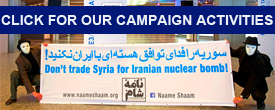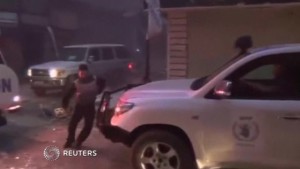 It depends on who is reporting. If it’s Fars News and other Iranian state-controlled media, then it’s obviously “the terrorists”. No need to check or verify. We all know it, don’t we? Well, let’s have a proper look.
It depends on who is reporting. If it’s Fars News and other Iranian state-controlled media, then it’s obviously “the terrorists”. No need to check or verify. We all know it, don’t we? Well, let’s have a proper look.
As part of a truce agreed on at the Geneva II talks last week, UN and other aid workers were allowed into the Old City of Homs to deliver much-need supplies to around 2,500 people who had been under siege for over six months, and to evacuate the children, women and the elderly.
On the second day of the operation, 8 February 2014, as the UN and Syrian Red Crescent convoy was arriving in the Old City, it came under attack with mortar shells and sniper bullets. Four aid workers were reportedly wounded. The Syrian regime and opposition immediately blamed one another for breaking the ceasefire.
Like most media outlets around the world, Fars News reported the headline-grabbing incident and quoted the UN’s humanitarian chief Valerie Amos saying the agency “will not be deterred” by the attack. [1] But the news agency, close to the Sepah Pasdaran (the Iranian Revolutionary Guards), could not help but add its own twist – following the example of the Syrian state TV – by quoting the governor of Homs accusing “terrorist groups” of firing the mortars at the police headquarters near the old clock, where the convoy was passing by.
There are two main points to make here. First, the governor of Homs, a representative of the regime, is obviously not a neutral source of information to quote without attempting to verify his claims, or at least quoting ‘the other side’ too. He is, in fact, famous for blaming ‘the terrorists’ for anything that has happened in Homs over the last three years.
Secondly, some of the UN staff and other aid workers told international media that it was “forces loyal to President Bashar al-Assad” that were behind the attack, although the UN did not officially blame either side because it “saw no evidence to back up that claim.” [2]
Khabar Online went even further than Fars News and claimed that “a Syrian armed group” not only fired “several mortar shells” on the UN and Red Crescent convoy but also “took a group of UN staff hostage.” [3]
ِAccording to the website, the ‘news’ is based on a report by the Al-Mayadeen News Network, which the report describes as a “news agency”. Al-Mayadeen is a reatively new Lebanese TV channel close to Hezbollah Lebanon and can only be described as a Syrian regime propaganda mouthpiece.
Moreover, we could not find any mention of this supposed kidnapping on Al-Mayadeen’s website. The only two reports that talk about the evacuation in Homs and the attack on the aid convoy do not say anything about kidnapping. [4]
Fars News also posted a CNN video report in English about the attack on the aid convoy, super-imposing its logo on the screen, as it usually does. [5] The report quotes the Syrian cameraman who captured the footage used in the report saying, “This is what happens… even when the UN is [present] inside the [besieged] Homs.” The report adds that the regime and the rebels “exchanged blame” for the attack.
Whether intended or not, the CNN report does not play the rest of what the man behind the camera says. If you watch the original video, [6] you will hear him repeatedly say “the besieged neighbourhoods and the UN are being shelled by the regime during the delivery of aid supplies to besieged Homs.” The man obviously thinks it’s the regime, not least because he uses the word ‘bombardment’ (in Arabic), which is normally used for regime strikes. The general impression one gets from his comments is that this is not that unusual, except that the UN is there.
In another activist video of the attack, shot a while before from above and used in many other media reports, we hear the person filming saying similar things: “mortar shells [fired] by the regime’s shabbiha [thugs] fall on the UN and the Red Crescent in front of the [police] headquarters in the middle of Homs.” [7]
Yet Fars News found it perfectly fine to say, in the description accompanying the CNN video on its website, that the aid convoy “came under fire in a besieged rebel district of Homs by militants, threatening a United Nations-led operation to bring food and medicine to the people and evacuate civilians inside.”
Needless to say, the news agency’s wires are widely recycled by countless Iranian newspapers, radio and TV stations that depend on it for this sort of news.
It remains to say that some of the opposition armed factions trapped in Homs may have well been the ones who fired the mortars, whether at the police HQ or the convoy itself, however unlikely this may sound. But it is equally plausible that it was the regime forces or some of the foreign militias fighting alongside them in Homs (Hezbollah and Sepah Qods) who wanted to disrupt the process. Even more plausible is the ‘conspiracy theory’ that it was a pre-planned attack by the regime forces in order to blame it on the opposition so that the latter appears inhumane during the second round of the Geneva talks. After all, the Syrian regime has a long record of doing such things: from regime forces dressed up as rebel fighters firing at protesters in Dar’a at the beginning of the revolution so as to support the regime’s narrative that there were “foreign armed gangs” trying to destabilize the country, to blaming the Ghouta chemical massacre on Saudi-backed opposition armed factions, despite all the evidence to the contrary.
COMMENT FROM NAAME SHAAM’S CORRESPONDENT IN HOMS:
The shooting and shelling in besieged Homs continued as the high-profile evacuation was ongoing. The attack on the UN and Red Crescent convoy was not the only breach of the ceasefire. See for example this video, posted by the local coordination committee, of a dozen corpses of people who, according the video, were killed by the regime shells while evacuating. [8]
Even more abhorrent was an alleged ‘human shield’ formed by the regime’s ‘shabbiha’ (or thugs, as Syrians call them) trying to prevent the humanitarian aid from entering the besieged areas. But the incident, which triggered heated debates among Syrians, cannot be verified and could have well been an exaggeration of a few shabbiha trying to do something stupid.
Finally, it is important to remember that the main demand of the people besieged in Homs for almost 200 days, as well that of the opposition representatives in Geneva, was to break the siege, not evacuate the most vulnerable (only 600) to another besieged area (Al-Wa’r).
The consequences of such evacuations could be devastating. In the short term, it is a recipe for a massacre of the men who remain inside. In the long term, it could lead to drastic changes in local demographics, even ethnic cleansing, regardless of whether this is an unintended consequence or a well-thought-through sectarian plan.
NOTES:
[1] http://www.farsnews.com/newstext.php?nn=13921120001345
[2] http://online.wsj.com/news/articles/SB10001424052702304558804579374232496899124
[3] http://www.khabaronline.ir/%28X%281%29S%28pmsbb4305nauz451dpkqy2o0%29%29/detail/337418/World/middle-east
[4] See the reports in Arabic at http://tinyurl.com/p6sohjl and http://tinyurl.com/owo3z52.
[5] http://english.farsnews.com/player.aspx?nn=13921121001520
[6] https://www.youtube.com/watch?v=dmQCSd0C3Co
[7] https://www.youtube.com/watch?v=Tnt-45HakEg
[8] https://www.youtube.com/watch?v=RQk2qKPGxwQ
 English
English  فارسی
فارسی  العربية
العربية 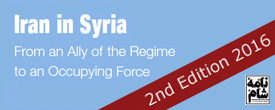
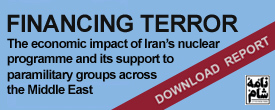
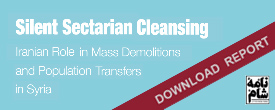
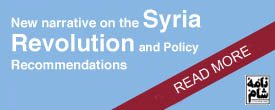

 On Twitter
On Twitter